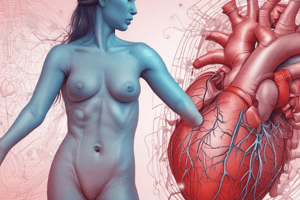Podcast
Questions and Answers
Which maternal condition is commonly associated with Transposition of Great Arteries (TGA)?
Which maternal condition is commonly associated with Transposition of Great Arteries (TGA)?
- Maternal diabetes (correct)
- Exposure to radiation
- Systemic Lupus Erythematosus (SLE)
- Drug use
What is the most common maternal condition associated with Asymmetric Septal Hypertrophy (ASH)?
What is the most common maternal condition associated with Asymmetric Septal Hypertrophy (ASH)?
- Drug use
- Systemic Lupus Erythematosus (SLE) (correct)
- Maternal diabetes
- Exposure to radiation
How does the maternal condition of Type 1 Diabetes Mellitus (DM) relate to Transposition of Great Arteries (TGA)?
How does the maternal condition of Type 1 Diabetes Mellitus (DM) relate to Transposition of Great Arteries (TGA)?
- Resolves TGA over time
- Has no impact on TGA
- Increases the risk of TGA (correct)
- Causes septal defects
What effect does Asymmetric Septal Hypertrophy (ASH) have over time?
What effect does Asymmetric Septal Hypertrophy (ASH) have over time?
Which maternal condition is NOT commonly associated with any of the cardiac anomalies mentioned in the text?
Which maternal condition is NOT commonly associated with any of the cardiac anomalies mentioned in the text?
How does drug use by the mother relate to infant’s cardiac findings?
How does drug use by the mother relate to infant’s cardiac findings?
What is the reason behind the term 'asymmetric' in relation to the left ventricle?
What is the reason behind the term 'asymmetric' in relation to the left ventricle?
What is the normal fetal heart rate (HR) range?
What is the normal fetal heart rate (HR) range?
Which condition is associated with delayed closure of Patent Ductus Arteriosus (PDA)?
Which condition is associated with delayed closure of Patent Ductus Arteriosus (PDA)?
What common finding is associated with infants having cardiac disease?
What common finding is associated with infants having cardiac disease?
What is a common noncardiac finding in infants with cardiac disease?
What is a common noncardiac finding in infants with cardiac disease?
What are infants with heart failure likely to experience during feeding?
What are infants with heart failure likely to experience during feeding?
Which condition is associated with tonsillopharyngitis?
Which condition is associated with tonsillopharyngitis?
Which hereditary disease is specifically reviewed in family history assessment?
Which hereditary disease is specifically reviewed in family history assessment?
(Trisomy 21) Down Syndrome is associated with which cardiac malformation?
(Trisomy 21) Down Syndrome is associated with which cardiac malformation?
What defect is associated with combination of Ventricular, Atrial, and Endocardial cushion defect?
What defect is associated with combination of Ventricular, Atrial, and Endocardial cushion defect?
Flashcards are hidden until you start studying




